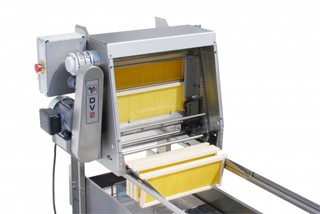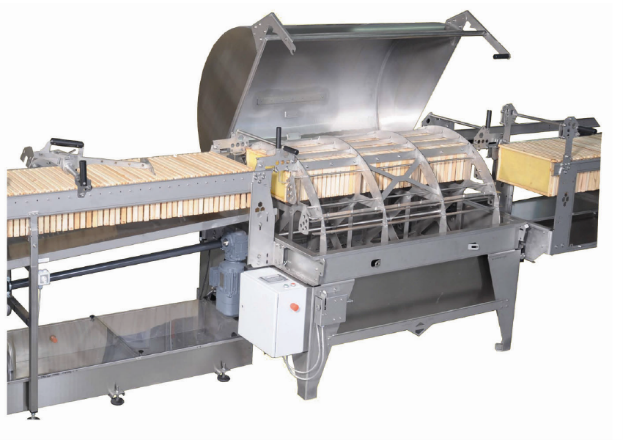Bees will sting if taken by surprise, so the beekeeper sprays the hive with smoke. This masks the bees’ sense of smell and prevents the transfer of intruder alarm signals which is done by pheromones. Inside the hive, there are wooden frames hanging side by side, each holding a honeycomb.
Once the wooden frames are collected, they are transported inside the honey factory, where the honeycomb frames are placed on an “uncapping machine”. This machine, like a razor, shaves off the wax caps of the comb cells filled with honey. Then, the frames are placed into the “honey extractor”, which it spins the honeycombs until all the honey is forced out of the cells. Afterwards, the honey is filtered to remove any pieces of wax that may have slipped through. Once all this is done, and the jars are previously vacuumed cleaned before being filled, the honey is ready for bottling or storing into barrels.

Figure 1: Uncapping machine – Stainless Steel

Figure 2: Honey extractor – Stainless Steel
Interestingly enough, some beehives contain smaller frames designed to produce honey that won’t be extracted from the honeycomb. Workers remove the frame and cut the honeycomb into pieces with a heated knife, sealing the wax around the honey inside the cell on the process. The beeswax lining of the honeycomb is assigned to making candles, furniture polish or lipsticks between others.
When producers have more liquid honey than they can sell, they let it granulate, allowing thus the development of sugar crystals that turn hard and white. When orders come in, they return it to its original liquid form by heating it up at 55ºC.
A traditional beehive can yield around 30 to 45 kg of honey per season, that’s much more than the bees need for themselves and the surplus is what we end up eating.






